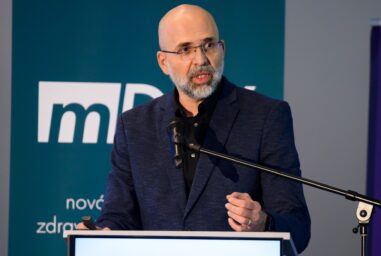Public health policy-making cannot do without health data. According to economist and director of the National Institute for Public Health in Austria, Professor Herwig Ostermann, it is important to distinguish between the evidence used to make medical decisions and the evidence used to design prevention programmes when working with data. Speaking at the 2nd Annual International Panel of the Permanent Conference on Healthcare in Prague, he also stressed that while individual countries have their own national registries, politicians should think about registries at the European level.
Although experts like to say that they can use data to answer any question, Ostermann says that there are limits to collecting them. According to him, obstacles consist of, for example, public opinion, the legal protection of personal data, the economic aspect of collection, or data interconnection. „It is important that evaluation strategies are conceived before measures are implemented. If you do so afterwards, the results are hard to publish and you do not get much insight from it,“ he stressed at the conference.
According to this Austrian economist, the creation of registers or samples is also important in primary data collection, where the selection of subjects is again crucial. „There are also online tools as real alternatives, and you need to be motivated to fill in a questionnaire,“ Professor Ostermann pointed out. He cited the example of the UK Statistics Authority, which involved 55,000 individuals in collecting data as part of the pandemic. Every week they took a test and filled in a questionnaire, which let Britain know where the location of the epidemic was and what age category was affected.

Health data at the pan-European level
National registries are important, according to the director of the Austrian Institute for Public Health. For example, politicians could not set a vaccination strategy without them. He said that states should also include hospital records on diabetes, cardiovascular diseases, critical factors, and so on in the registries. According to Ostermann, Finland is an example of good data infrastructure in healthcare.
Austria is also trying to improve in the area of health data. „We have created a microdata office centre. Anyone who wants to organize data through registers can use this centre,“ Ostermann told the conference. He provided the example of vaccination data that can be linked to hospital admission data. He added that in Austria they have a problem with combining hospital registers with health insurance registers.
Although there are national registries of health data on, for example, cancer patients, the director of the National Institute for Public Health in Austria said that countries should also think about introducing registries at the pan-European level. „If we had a European register, combining or exchanging information would be much easier,“ he says.
Mohlo by vás zajímat

Differences between evidence-based medicine and prevention
However, Ostermann said a distinction must be made between the evidence on which medicine is based and the evidence used to design prevention programmes. „But it is not quite right to compare evidence-based medicine with acute care measures in preventive care. For example, a certain amount should be invested in cancer treatment, but comparing that to a certain amount for oncological preventive care does not make sense to me,“ he said.
But for both directions, so-called efficiency analyses are important. „When it comes to evidence-based public health, we have efficacy analyses often compared to real-world experiments. They also look at effects with a time lag and which are difficult to attribute to a specific measure,“ explained Professor Ostermann. He cited smoking and lung cancer as examples.

„When it comes to evidence-based medicine, we measure immediate or short-term effects. Identifying costs in medicine is measurable for similar alternatives, but in public health it is more difficult, for example, in situations where indirect costs are considered,“ he added.
Assessment and economic issues
Public health data then play an important role in assessing and deciding on changes. Ostermann reminded the audience that clinical assessments, efficacy analysis and the like are also needed. The evaluation is then usually carried out at the national level, but economists, scientists, and lawyers are also involved.
When decisions are made on the basis of data and evidence, governments or public institutions have different alternatives. „That is why it is also difficult. For example, instead of investing in cancer therapy, the Ministry of Health can invest in a prevention programme,“ the Austrian economist said.
For example, several years ago, his office tried to define the optimal strategy for preventing osteoporosis. Certain groups of people were selected and scientists measured their bone density. „The result was that £2,300 was the right cut-off point where investment was still effective in preventing osteoporosis. We do not get absolute answers, but a perspective that compares one alternative with another,“ says Ostermann.

So in practice, health policies need to apply economic strategies whose results outweigh the invested costs. „But it is not just a question of input and investment, time also plays an important role, because prevention programmes provide direct and indirect benefits,“ said the director of the National Institute for Public Health in Austria.
Photo: Stanislav Pecháček
Miroslav Homola












